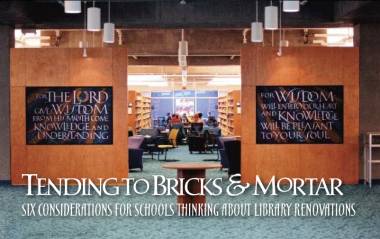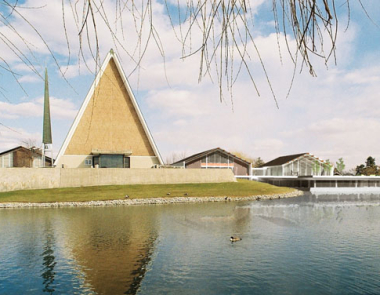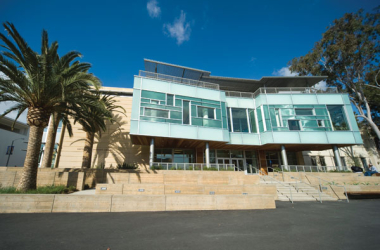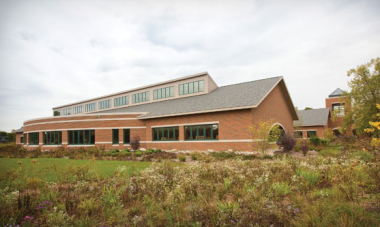
The decision to overhaul a theological library is often straightforward: Collections outgrow their space; old buildings become leaky, drafty, and never have enough outlets. But many libraries limp along for years at a time, plugging the leaks, relying on extension cords, storing books offsite, and otherwise making do. There are always other institutional priorities and seldom any available funds for renovation or building.
At some point, though, enough is enough — it's time for a new library already! But exactly when is that point?
In the past five years more than half a dozen theological schools have taken on major library building projects. Conventional wisdom suggests that brick-and-mortar libraries are going out of favor as information moves online, but the reality is different. Library buildings continue to be important, and these cases offer glimpses of what is valuable in libraries today.
Library renovations are costly, but for the schools that undertake them, the results seem to make the expense worthwhile. Nevertheless, boards and administrators should approach any library overhaul with eyes wide open. Here are six considerations for boards and administrators thinking about improving the library facilities.
1. "If it hasn't been renovated in recent memory, it's not serving the needs of the community."
Those words come from David Bundy, associate provost for library and information technology at Fuller Theological Seminary in Pasadena, California. Fuller's David Allan Hubbard Library — combining a new building and a major renovation — opened in May 2009 with increased capacity, improved study space, and technological capabilities that can support today's students and faculty (see "Honoring a Revered President Spurs New Donations" below). As Bundy points out, information access is a fast-changing field.
Sometimes it's not just outdated library systems or spaces that are the basis for updates; changes in other parts of the institution can affect library usability as well. Leaders of Concordia Theological Seminary in Fort Wayne, Indiana, knew for a long time that library upgrades were essential, because the old 15,000 square-foot library was simply too small for the seminary's 175,000-volume collection.
 |
| Architect's rendering of the new library at the Concordia Theological Seminary in Fort Wayne, Indiana. From left, the seminary’s Kramer Chapel, the existing library building, and the new library, connected to the old building by a bridge.
(Photo courtesy of MSKTD & Associates)
|
But one feature that the planners called for — 15 group study rooms — was a response to the new curriculum that Concordia had recently adopted, which was more interactive than in the past. The way students needed to study and complete assignments had changed, and library planners paid attention.
In 1916, the founders of Candler School of Theology in Atlanta built the institution so that everything could take place in one building near the center of Emory University's campus. But after decades of growth, the library, classrooms, and offices ended up in different buildings. Candler is currently in the midst of a $58.5 million building project. About half of that will pay for classrooms and offices, but the other half is for a planned new library that will include a lecture hall, group study spaces, a media center, and a learning commons combining a traditional reference area with a technology support center. "At the end of the day, what we're doing is returning to the wisdom of having the library, classrooms, and faculty offices in one space to encourage a sense of community among students, faculty, and staff," says M. Patrick Graham, director of Candler's Pitts Library.
2. "A beautiful and useful library space communicates how the institution values scholarship, just as a beautiful and useful chapel communicates how the institution values spiritual life and discipleship."
Eileen Saner, librarian at Associated Mennonite Biblical Seminary in Elkhart, Indiana, says this insight helped guide the planning process for her school's new library, which opened in 2007 (see "The Board Raised All the Right Questions" below).
Regent College and Carey Theological College in Vancouver, British Columbia, wrestled with the challenge of locating its new library underground. "People want to come to places that are comfortable and attractive and where they can learn, whether they're turning on their Kindle or opening an ancient text," says Cindy Derrenbacker, the former library director at the two schools' combined John Richard Allison Library. To make the subterranean library as comfortable and attractive as possible — and to avoid a basement feel — planners raised the ceiling height by a foot, installed skylights over the study carrels, and included plenty of space for art.
Until 2006, Catholic Theological Union (CTU) in Chicago was located in an old hotel, and the library took up two floors of old guest rooms — each room with its own bathroom. "They built shelves right over the bathtubs to gain space," says Melody Layton McMahon, director of the school's Paul Bechtold Library. (McMahon's article, "More than a Study Hall," which appeared in the Spring 2010 issue of In Trust, debunked several assumptions about the future of theological libraries.)
Five years ago, CTU opened its new building, which includes a 95,000-square-foot library on the fifth floor. Now, says McMahon, "Our library is really bright and cheerful. It's the kind of place where people want to come and spend their time."
One concern planners often have is how to integrate a new building or addition with existing library space. "One of my pet peeves is when additions are built on to existing library buildings and nothing matches," says Fuller's Bundy. "I was determined not to have that happen here. One should not notice the old from the new. Programmatically and aesthetically, it should be one single building."
It can also be difficult to design a new building as an integrated part of the campus. "The challenge for Concordia was how to construct a large scale building without it disrupting the small scale feel of the campus," says the Rev. Robert V. Roethemeyer, director of Concordia's Walther Library. Concordia's 25-building campus was designed by renowned modernist architect Eero Saarinen, so planners paid careful attention to how the new library would fit in with the campus' unified design.
3. Sticker shock is unavoidable.
More than a decade ago, Princeton Theological Seminary considered renovating the older of its two libraries, Speer Library, which opened in 1957. (Luce Library opened in 1994.) When trustees learned the estimate for a bare-bones project was $11 million, they took a pass. In 2007, they revisited the library issue: After they revised their plans and considered multiple options, they decided to move ahead and replace Speer Library with a new 92,000-square-foot building.
The seminary has planned some exciting features for the new building: a large digital scanning studio, technology-rich meeting rooms, space for instructional technology staff, expanded rare book room and archives, a café, and an atrium between the new building and Luce Library, effectively creating one large library. The $75 million price tag reflects that.
"I don't know how you prepare people for sticker shock," says Stephen D. Crocco, the seminary's James Lenox Librarian. Particularly for trustees who were around when the initial $11 million project was under consideration, Crocco says, the cost of the new project likely sounds exorbitant. While Princeton is still working on its fundraising goal, the board authorized the project to move ahead last July 1, in part because construction costs were a bargain during the economic downturn.
Even for a school considering a library project just a fraction of Princeton's cost, funding can be difficult. In Indiana, Concordia Theological Seminary raised 50 percent of the $13 million it needed before construction began. "We experienced a great trajectory of fundraising before October 2008," says library director Roethemeyer. But since then, fundraising has been slow, so Concordia is focusing on each phase of the project rather than a final completion date.
Associated Mennonite Seminary had also failed to reach its fundraising goal before breaking ground. But after construction started, donors emerged, and it seemed some were simply more interested in the project once it was underway.
While sticker shock and fundraising are real challenges, the seminary librarian believes that it is important to raise enough money so as not to cut corners — at least, not important corners.
4. Everybody has a stake in the library.
When it came time to decide on furnishings at the combined Regent-Carey library in Vancouver, planners enlisted the help of students to try 11 different chairs that were under consideration. Requesting their feedback was an easy way for planners to help students feel ownership of the new facility.
But students aren't the only interested ones. "Libraries are a favorite space for events for donors and public lectures," says Candler's Graham, who acknowledges that the library staff now must turn students away when some of these events take place. The new Pitts Library will have a designated space for lectures and donor events.
Stakeholders extend beyond the campus community, of course: During the planning process at Associated Mennonite, "We realized that most people in the community were not even aware of the seminary," says David Boshart, former board chair. "This provided an opportunity to build a library that would be a place of hospitality to the local context."
And sometimes stakeholders are even more distant: Princeton aims to have its new library serve scholars and other theological libraries worldwide by digitizing parts of its collection that are out of copyright and connecting remote researchers via video conferencing to meet with Princeton faculty members or librarians for collaboration or training. There will also be studies and offices available for visiting scholars and librarians from overseas.
But even if stakeholders are everywhere, it's important for librarians to have a privileged voice in the process, says McMahon, the librarian at the Catholic Theological Union. As the people most familiar with the library and its patrons, they have a sense of the whole operation, and can spot potential concerns with details — even as basic as the type of shelving or the location of copy machines.
5. It's hard for the library staff to be innovative when they're regularly rescuing and retrieving materials.
The Pitts Library at Candler is in "a lovely old building in the center of campus," says Graham. But because of its age and condition, the building requires the library staff to have a finely tuned disaster plan that "we've had to practice more than we would have liked," says Graham. Pitts has good company when it comes to spending time rescuing books — in older buildings, some problems, like water damage, are a particular threat.
But other non-disaster situations can burden the staff, as well. For instance, almost every institution interviewed for this article mentioned having to store library materials elsewhere because of insufficient capacity. Increasing shelf space frees up the staff for more forward-thinking, valuable work.
That's one reason why Princeton is doubling its capacity to make space for a million paper books, decreasing the amount of time library staff will need to spend on the hunt. At Concordia, a planned 21,000 square feet of finished space will nearly double capacity, adding space for 150,000 more volumes. That will help the staff be able to attend to two interesting spaces in the works: first, a biblical workshop that includes texts and tools used for scriptural exegesis and to support the Greek readings courses; and second, a curriculum room that includes religious education materials and seating spaces for all ages, providing resource texts for Bible study, adult education, confirmation, children's ministry, and more.
6. In the end, it's worth it.
Sure, a library building project is fraught with headaches: slow-to-materialize fundraising pledges; delays due to permits, contractors, and other unforeseen circumstances; determining everything on the wish list and then deciding what the budget will allow. But a new library signifies more to a theological school than just a collection of books - or online resources, for that matter.
"At Regent, we were able to create a lovely space where people can read and learn and discuss the things of God," says Derrenbacker, the former library director. "In many ways it reflects the essence of theological education."
"It's extraordinary to watch from the moment the shovel goes in, knowing that thousands of hands have gone into making this happen," says Jan Love, dean at Candler. "And having a grand new place to carry out your mission is energizing in itself."
"The biggest challenge facing the board in the planning and building process was having the nerve to execute the plan," says Boshart, the former board chair at Associated Mennonite. Part of the board's initial hesitation was about committing to a generous, hospitable facility when there were significant questions around emerging delivery systems for seminary education. But just before committing to the build, with more than half the money raised, the administration called a special meeting of the board to ask one question: "Is there a future for residential seminary education?"
For the hesitant, that clarified the library decision. Says Boshart: "It was surprising and interesting how quickly the board came to a unanimous decision to move forward with the building."
Honoring a revered president spurs new donations
Fuller Theological Seminary's McAlister library had been built in two installments, first in 1962 and later in 1978. Forty years after it first opened its doors, it was clear that renovation was in order. "Almost everything that could be wrong with a library building was wrong with it," says David Bundy, associate provost for the library — starting with the fact that "the building had gotten very ratty and ugly and was a very unwelcoming place for people to study and think."
Collections had outgrown the space available, there was minimal flexibility in the way space was configured, there wasn't enough power for current technological demands, and wireless signals were weak. Accreditation teams visiting Fuller had noted that the library facilities needed improvement. Originally, Bundy says, the institutional plan was just to tear down the building and start over.
But when it finally came time to address the library's many issues, Fuller learned the old poured-cement-and-iron building would cost more to tear down than to fix. After they gutted the structure, Bundy says, "We discovered a lot, and it was all good news. It was very well built." (Some of the building inspectors appreciated its solid construction so much, they told him that they'd want to be inside if the world were ending.)
The board was "always encouraging" about the project, Bundy says, although that did not translate immediately into fundraising. Eventually, however, the decision to name the building after David Allan Hubbard, the late president who led Fuller from 1963 until 1993, helped attract donors who wanted to honor their friend and mentor with a contribution to his namesake library. The board raised most of the $30 million needed for the project.
But raising money wasn't the board's only role. "One of the things the trustees did for us was to trust us in our processes," says Bundy. The library staff conducted focus groups with students, faculty, and trustees, visited other institutions, and worked with library consultant Aaron Cohen, who helped Bundy and other leaders at Fuller to articulate a vision and sharpen their plans. "The way he helped us think about things transformed the project," Bundy says.
 |
| The new David Allan Hubbard Library at Fuller Theological Seminary quadruples the space available for books, but it also includes new light-filled study areas and a terrace equipped with wireless Internet connectivity.
(Photo courtesy of Don Milici)
|
The new David Allan Hubbard Library opened in May 2009. While the original 38,000-square-foot McAlister library received new ceilings, floors, a computer lab, and an improved fire safety system and wireless capabilities (as well as the new name), the new 47,000-square-foot addition - which is connected to and fully integrated with the old structure — quadruples the library's previous holdings potential to 1.4 million items and features five conference rooms with audio-video capabilities, a terrace overlooking the campus (and wireless access outside), and additional space for special collections.
Fuller's digital holdings and online materials are larger than its print collection, but Bundy notes one of the library's guiding principles: The physical space needs to be able to take care of the needs of the community, not to favor digital books over paper ones or vice versa. "The question to answer is not which medium, but how to improve access and availability of information and service."
"The board raised all the right questions"
In 1985, when librarian Eileen Saner began working at Associated Mennonite Biblical Seminary in Elkhart, Indiana, the institution was gearing up for a new library. They started working with an architect in the early 1990s, but planning was shelved when the school's president died unexpectedly, forcing financial retrenchment and a reassessment of priorities.
Finally, in 2007, the seminary opened its new 20,000-square-foot library, which features increased book capacity (from 100,000 to 150,000 volumes), three group study rooms, windows that maximize natural light, and sustainable, local building materials. The library soon became a favorite place for students, faculty, and community members alike: library statistics show that in 2007-08, occupancy of the new library was about 70 percent higher than that of the old library two years earlier — even with 18 percent fewer students on the campus. Additionally, students checked out 12 percent more materials and faculty checked out 20 percent more materials compared to average circulations of the nine previous years. Check-outs by community borrowers increased 45 percent.
 |
| At Associated Mennonite Biblical Seminary, the new library features clerestory windows that illuminate the central reading area and stacks.
(Photo by Peter Ringenberg)
|
The $8.1 million building project — which includes the bookstore and a gallery — also benefited the rest of the institution by freeing up much-needed space. The old library reading room became a lounge, the old bookstore was converted to offices, and the old lounge was refitted as a meeting room. "We looked at this as an opportunity to reinvigorate the whole campus, not just to address the needs of the library," Saner says.
The board supported the building process in two key ways. First, when the building planning committee proposed to the board that the new library be a green building built to LEED-certification specifications, "The board raised all the right questions," Saner says, and eventually was convinced by expected long-term energy savings and the opportunity to showcase its commitment to stewardship. And in January 2006, the board voted to move ahead with the scheduled groundbreaking even though all the project funds hadn't yet been raised.
The goal for fundraising, which included a $1.8 million endowment for operating costs, was reached later that year, several months before occupancy. While the extended time frame was difficult, Saner takes the long view. "I think we have a much better building than we would have, if we had built it in 1996," she says. Her words of wisdom for seminaries that find themselves in similar situations: "The planning process may be long, but it allows time to learn from other library buildings and to observe both user preferences and the changing information landscape."
When was your library built? When was it renovated?
In a world where information overload is more common than information scarcity, libraries and their staffs remain an important asset for theological schools. In 2010, the Association of Theological Schools asked member institutions to report building and renovation statistics for libraries. This table reports on the survey results.
Of the 215 libraries reporting data, nearly 60 percent were built between 1940 and 1970. Only 64 percent have ever been renovated in their lifetime. (For this study, a "renovation" may indicate a building project like an addition, a new classroom, or an expansion; the replacement of HVAC equipment; technology improvements; or the repair of a facade.)
Whether physical or virtual, the library serves as a gathering place for students to learn and apply critical thinking and research skills.
—Barbara Kemmis
Director of Member Services
American Theological Library Association
